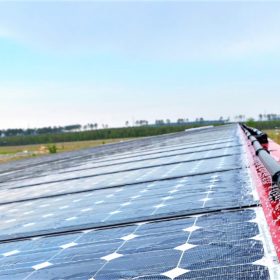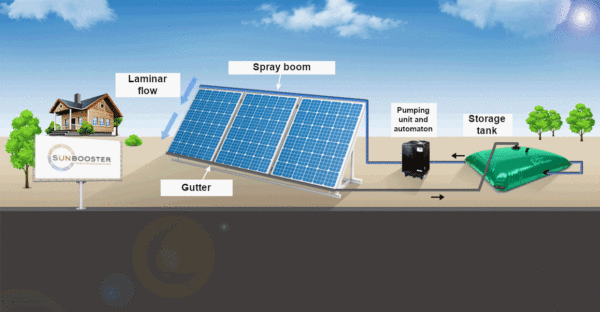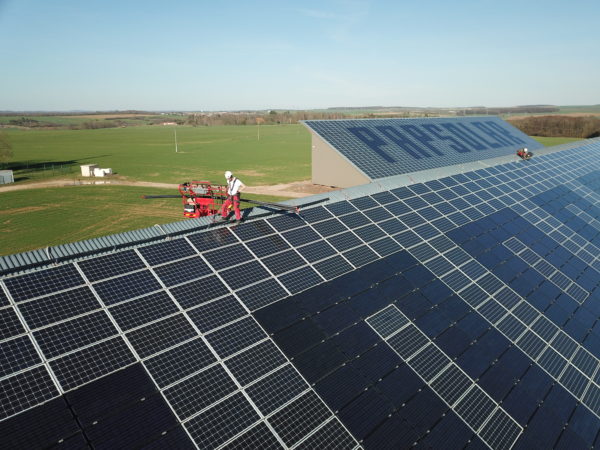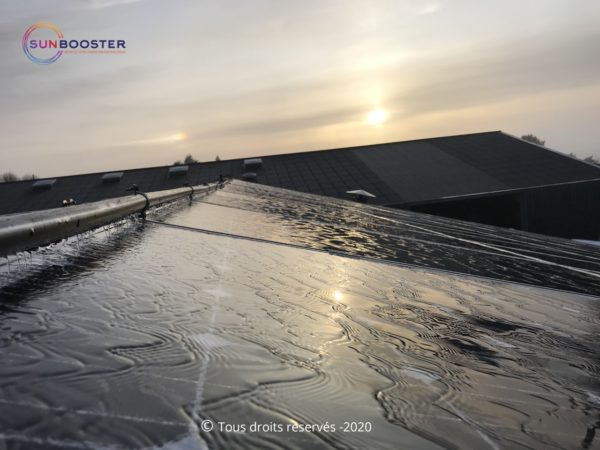
France's Sunbooster has developed a technology to cool down solar modules when their ambient temperature exceeds 25 C. The solution features a set of pipes that spread a thin film of water onto the glass surface of the panels in rooftop PV systems and ground-mounted plants. The cooling systems collect the water from rainwater tanks and then recycle, filter and store it again. The company claims the technology can facilitate an annual increase in power generation of between 8% and 12%.
French PV system installer Sunbooster has developed a cooling technology for solar panels based on water. It claims its solution can ramp up the power generation of a PV installation by between 8% and 12% per year.
The solution consists of a set of pipes that can surround a rooftop PV system or ground-mounted plant. The pipes are used to spray a thin film of water onto the glass surface of the modules.

Image: Sunbooster
“The company had originally experimented with a water-vaporizing solution, but this produced thermal shocks for the PV system,” Sunbooster CEO Grégory Boutteau told pv magazine. “Furthermore, the drops produced by this cooling system had a negative impact on solar light absorption.”
Water flow
The company’s solution is a patented pipe with a number of very small holes, so special installation skills are required. Stored rainwater is pushed into a ramp at the edge of the panels. Water then flows onto the surface of the modules and immediately lowers the temperature.
“The materials used to build the pipes have been chosen based on their quality, reliability and durability,” Boutteau said, without providing additional details about the patented technology. “Pipes are UV-resistant and drilled with holes – their number and size are defined by our design and engineering office in respect of our patents.”
The water only spreads across the glass surface of the panels and does not touch any plastic parts, such as the backsheets or other components. “It can be considered in the same way as rain, and for this reason it does not affect the warranty of the modules,” Boutteau said.

Image: Sunbooster
The system is set in motion by a temperature sensor which triggers the water spread when ambient temperatures exceed 25 C. Although the water may have some influence on the modules’ light absorption, this is fully compensated by the increase in power yield that can be achieved by preventing temperatures from surpassing 30 C, Boutteau said.
The cooling systems collect the water from a rainwater tank. And after the water is used, it can be recycled, filtered, and stored again. “Our Sunbooster solution works in closed circuit and doesn’t need additional water,” Boutteau explained.
Cost considerations
The technology, which can be applied to PV systems and solar plants built at all kinds of tilted angles, currently costs almost €250,000/MW. But Sunbooster expects to more than halve that to between €100,000/MW and €150,000/MW within the next two years.
“We are now developing new partnerships with big players,” said Boutteau. “And this, combined with the economies of scale of large ground-mounted projects, will help us reduce our costs significantly.”

Image: Sunbooster
So far, the technology has only been adopted in projects backed by cost-offsetting incentives. However, the company claims that it has started to sharply lower the cost structure of its systems to support unsubsidized projects in the near future.
For a 10 MW PV plant, around 25 km in pipes would be needed, which complicates logistics and installation, Boutteau said. “But the system is easy to deploy with the necessary skills,” he added.
Sunbooster currently needs to send teams out to install its systems. However, the company plans to train partners who are capable of deploying its technologies at a global level, in line with its standards. “Our partners will be referenced in our network validated by an internal certificate delivered by Sunbooster,” Boutteau said.
He added that the adoption of a similar cooling system could increase the complexities of projects and the number of possible variables. “Installing our system in Spain or Germany is not exactly the same thing,” Boutteau stated. “Furthermore, there many other water-related factors that must be taken into account, such as water vaporization rates, humidity and available water resources.”
Lắp đặt điện mặt trời Khải Minh Tech
https://ift.tt/2X7bF6x
0906633505
info.khaiminhtech@gmail.com
80/39 Trần Quang Diệu, Phường 14, Quận 3
Lắp đặt điện mặt trời Khải Minh Tech
https://ift.tt/2ZH4TRU
Không có nhận xét nào:
Đăng nhận xét